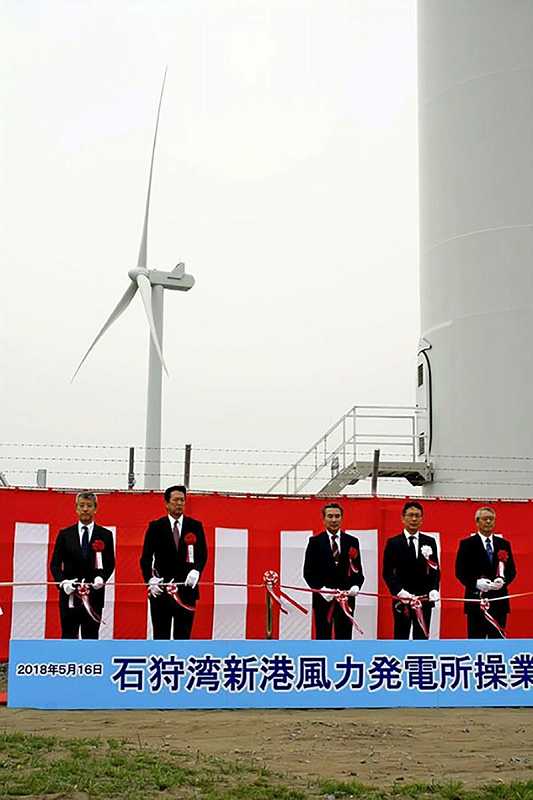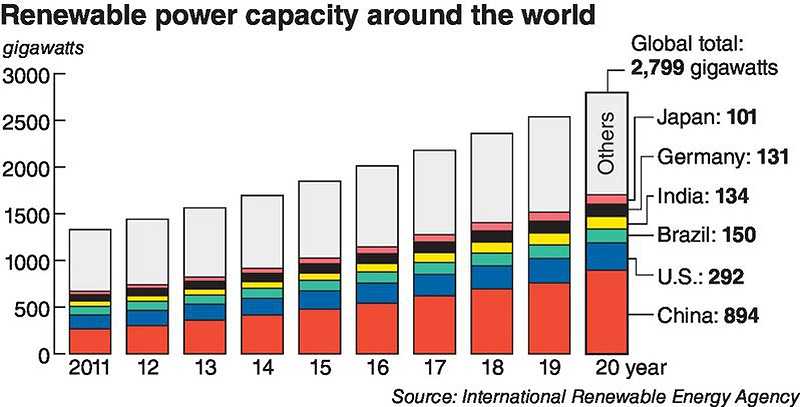Road to Decarbonization 2 / Inconsistent nature of renewable energy cause for concern

The opening ceremony of a wind power plant is held in the Ishikari Bay New Port district, in Hokkaido, in May 2018.
November 20, 2021
About one hour’s drive from New Orleans is a district filled with petroleum and natural gas plants. On Oct. 14, the Louisiana state government and a leading U.S. gas company announced plans to construct a plant to manufacture hydrogen for fuel, spending $4.5 billion (about ¥500 billion) on the project.
The plant is notable for the fact that 95% of the carbon dioxide generated from the production of hydrogen from natural gas at the facility will be captured.
The captured CO2 will be permanently sequestered more than 1 kilometer underground, thus curbing 5 million metric tons per year of carbon dioxide emissions. The envisaged plant is predicted to be the world’s largest hydrogen manufacturing complex equipped with so-called carbon capture and storage (CCS) technologies.
Louisiana has suffered significant damage from powerful hurricanes in recent years, and the frequent occurrence of abnormal weather has been said to be closely linked to global warming. Louisiana Gov. John Edwards said at a press conference, “There is no state in the nation more affected by climate change than Louisiana,” emphasizing the importance of decarbonization.
The administration led by U.S. President Joe Biden is placing its hopes on CCS technologies as a reliable way to reduce CO2 emissions. On Oct. 6, the U.S. Energy Department announced that it will invest $45 million in research and development in CCS technologies.
Seeing a business opportunity, large companies and start-ups have entered the CCS industry one after another. One estimate projects that the global CCS market will grow from $2.8 billion in 2020 to $4.9 billion in 2026.
Yet, the practical application of CCS technologies has just begun and experts have cautioned against overconfidence, due to technological challenges and safety concerns.
European countries, which have increased their generation of electricity through such renewable energy as wind and solar photovoltaic power in a bid to realize decarbonization, have faced unexpected difficulties this year. The operational pace of wind plants dropped due to unseasonal weather, and the lower output was made up by gas-fired power plants. Demand for gas soared, and gas prices have jumped more than five fold from the start of this year.

In Britain, 20 electricity and gas retailers have gone under because they could not pass the skyrocketing cost of procuring gas on to customers, forcing 2.04 million households to switch providers. This has demonstrated the weakness of a society dependent on renewable energies whose output fluctuates with the weather.
Hundreds of people protested in Madrid in September, objecting to a sharp increase in electricity rates in a demonstration organized by Spain’s ultra right Vox party. According to local reports, senior members of the party spurred people to protest by saying the rate hikes amounted to “a seizure of assets.”
The danger has also emerged that government measures to fight climate change could be used politically.
Although the international community is working to realize the common goal of decarbonization, it is also facing strong headwinds.
Fears of higher rates
The Ishikari Bay New Port district faces Ishikari Bay in Ishikari, a city north of Sapporo. Inside the district is a 3,022-hectare industrial complex, equivalent to half the area surrounded by the JR Yamanote Line in central Tokyo.
The area has changed completely since 2012 when feed-in tariffs, or FIT, were started, a system under which electricity generated from renewable energy is purchased at fixed prices set by the government.
A plot of land in the district can be secured at a relatively low price, and the area is blessed with winds that blow stably. Wind power plants have been installed one after another, and their combined power output has reached 60,000 kilowatts. Multiple solar power plants are also operating there.
Offshore, construction will soon start on a wind farm with a total power output of 110,000 kilowatts, with operations envisaged to start in 2023. Upon completion, there will be 14 giant windmills offshore.
The city government of Ishikari has set up a 100-hectare “100% renewable energy area” in part of the industrial complex. The municipal government aims to procure all the electricity needed in the area from wind and solar power.
“The time will soon come when 100% renewable energy is essential for business activities,” said an official who leads the government division that is responsible for attracting companies to operate their businesses in the area.
The municipal government wants to encourage businesses to come to the city but many difficulties are involved.
The output from wind and solar plants, be they onshore or offshore, varies with the weather, so alternative energy sources must be secured to make up for times of decreased output. The city has plans including the construction of storage facilities for surplus electricity, and the use of hydrogen — a next-generation fuel — in times of emergency. Both these ideas, however, are still on the way to practical application, and there are significant costs involved.
The offshore wind farm that is envisaged operating in the Ishikari Bay New Port district is seen by the central government as a vital measure for increasing the output of renewable energy. It contains significantly more room for wind generation facilities compared to wind and solar power plants onshore — suitable sites for onshore facilities have become more scarce than ever.
However, locations deemed appropriate for offshore wind farms are mainly in the Hokkaido, Tohoku, and Kyushu regions. For the power generated from these plants to cover the demand for electricity in such big cities as Tokyo, a large amount of electricity needs to be distributed stably.
If enough offshore wind plants were to be installed to generate 45 million kilowatts of electricity in 2050, the Organization for Cross-regional Coordination of Transmission Operators, Japan estimates that the capacity of inter-regional networks of power transmission lines would need to be boosted by about 19 million kilowatts.
The needed investment is estimated to be as much as ¥4.8 trillion. If the situation is left up to power utilities, it is highly likely electricity charges will go up.
Electricity charges in Japan are already high by international standards. Compared to 13 cents per kilowatt-hour in the United States, people in Japan pay 25.4 cents, or about twice as much. Fuel costs for thermal power plants have risen due to the suspension of nuclear power plants, but the cost of FIT has also grown because of the increased use of renewable energy.
Can the people accept the greater financial burden that will accompany the decarbonization drive? Relevant discussions need to be held swiftly.
"Business" POPULAR ARTICLE
-

Tokyo Economic Security Forum to Hold Inaugural Meeting Amid Tense Global Environment
-

Keidanren Chairman Yoshinobu Tsutsui Visits Kashiwazaki-Kariwa Nuclear Power Plant; Inspects New Emergency Safety System
-

Imports of Rare Earths from China Facing Delays, May Be Caused by Deterioration of Japan-China Relations
-

University of Tokyo Professor Discusses Japanese Economic Security in Interview Ahead of Forum
-

Japan Pulls out of Vietnam Nuclear Project, Complicating Hanoi’s Power Plans
JN ACCESS RANKING
-

Tokyo Economic Security Forum to Hold Inaugural Meeting Amid Tense Global Environment
-

Keidanren Chairman Yoshinobu Tsutsui Visits Kashiwazaki-Kariwa Nuclear Power Plant; Inspects New Emergency Safety System
-

Imports of Rare Earths from China Facing Delays, May Be Caused by Deterioration of Japan-China Relations
-

University of Tokyo Professor Discusses Japanese Economic Security in Interview Ahead of Forum
-

Japan Pulls out of Vietnam Nuclear Project, Complicating Hanoi’s Power Plans

























